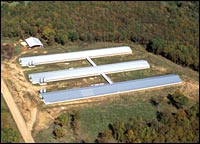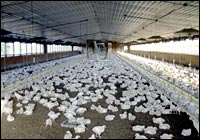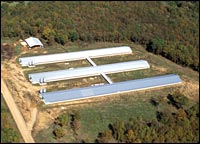A person driving through the South might notice the chicken houses dotting the hills and flatlands. He might marvel at the larger ones, as long as a football field. He might react to their gagging stench for a moment, and then forget as he travels on. But those who live near the structures — stuffed with as many as 25,000 chickens each — combat the odor and health hazards daily.

Not yer pappy’s chicken coop.
Photo: USDA.
“There’s a horrible odor, a stench, and I have flies and rodents digging in, trying to get into my house,” says Bernadine Edwards, whose 39-acre farm near Owensboro, Ky., is surrounded by 108 chicken houses within a two-mile radius. “It is unbelievable.”
The 65-year-old school bus driver, who recently bought a purifier to help her breathe easier in her home, says the value of her property has plummeted since the chicken houses arrived in the early 1990s. “I’m too old to start over,” she says. “I can’t afford to. My house is paid for.”
Edwards is not alone. Over the last 15 years, the country has seen a boom in chicken farming. Today, the industry is serving a cocktail of injustice and pollution to rural residents, and most of them aren’t in a position to fight back.
Growing Pains
Since the early 1990s, observers say, thousands of chicken houses have cropped up across the South as consumer demand for poultry has grown. Today, the U.S. is the world’s poultry leader, with production of broilers, turkeys, and eggs valued at $29 billion in 2004, according to the National Chicken Council. Broilers — chickens raised for meat — generated $22 billion of that. The leading broiler production states in 2004 were Georgia, Alabama, and Arkansas, which is home to the world’s largest poultry producer, Tyson Foods.
Like chemical companies and industrial hog farmers, poultry producers don’t tend to place these concentrated animal-feeding operations, or CAFOs, in ritzy neighborhoods beside multimillion dollar McMansions. Instead, chicken houses commandeer spacious rural areas, where local residents need the income and their neighbors won’t speak out against them — or are unaware of the factories’ environmental and health consequences.
“These companies seek rural areas where unemployment, or underemployment, is high and people are desperate for ways to stay on the farm,” says Aloma Dew, a Sierra Club organizer in Kentucky. “They assume that poor, country people will not organize or speak up, and that they will be ignorant of the impacts on their health and quality of life.”
The companies provide local growers, who work under contract, with chicks, feed, medicine, and transportation. Growers take care of the rest, investing hundreds of thousands of dollars in construction, maintenance, and labor costs. When the company requires upgrades, the costs fall to the growers. The massive amounts of manure, too, are their responsibility. (In Arkansas alone, chicken farms produce an amount of waste each day equal to that produced by 8 million people.) Payment is results-oriented, based on measures like total weight gain of the flock. It’s a system, says the United Food and Commercial Workers, that leaves 71 percent of growers earning below poverty-level wages.

A far cry from free range.
Photo: USDA.
If growers protest, companies can cancel their contracts, leaving farmers responsible for incurred debt, says Laura Klauke, director of contract agriculture reform at the North Carolina-based Rural Advancement Foundation International. And that debt can be substantial: since banks in the region will more readily loan money for poultry houses than other types of agriculture, Klauke says, some farmers put everything on the line, mortgaging their property to make a living this way.
“If those contracts are canceled — and they can be if the farmer doesn’t do what the industry wants — then that farmer could literally be homeless,” said Klauke. “I know farmers who have been in that situation.” (Industry representatives did not respond to requests for comments on this or any of the concerns expressed in this story.)
Pecks and Effects
More frightening than the economic balancing act may be the health and environmental hazards posed by chicken farms, from the arsenic, ammonia, and other chemicals found in feed and manure to threats from diseased animals. While traditional farming can carry similar risks, CAFOs are especially hazardous because of the tight confinement that defines them. “The fact is, you put hundreds of animals in a very small area, that creates problems that would not exist if these animals were distributed across the countryside,” says Barclay Rogers, who successfully litigated a pollution case against Tyson in Kentucky in 2003.
Rogers says the industry grew rapidly with little regulatory constraint, and has been “riding roughshod” over land and people. While CAFOs must follow federal environmental laws such as the Clean Water Act and Clean Air Act, he says, many growers try to “duck and weave” regulations. “The industry may stand up and say we are over-regulating, and that we have all of these permits, but the practical aspect is that they have devised many ways to avert pollution controls,” said Rogers. “That’s why we are seeing the fouling of water and air. We just now are coming to grips with these consequences, as people are catching up and realizing what has happened to them.”
Last year, Oklahoma Attorney General Drew Edmondson (D) filed suit against Tyson, Cargill, and several other poultry companies, seeking to stop water pollution caused in his state by soiled chicken litter dumped in Arkansas. Polluted runoff, also known as non-point source pollution, is the biggest remaining water pollution problem in the U.S., according to the EPA, which cites agriculture as the largest source of such pollution. Edmondson described the problem as “an economic development issue, an agricultural issue, and a quality-of-life issue.” Not to be outdone, Arkansas Attorney General Mike Beebe (D) — who is running for governor — countered in November by suing the state of Oklahoma directly, asking the U.S. Supreme Court to prohibit Oklahoma from forcing his state’s poultry farmers to adhere to the stricter standards. Both cases are still pending.
This messy interstate situation is just one indication of the many unknowns at stake. “Some of the [environmental] consequences of these CAFOs are just not clear,” said Van Brahana, a geologist at the University of Arkansas who studies groundwater. “What we do know is when you have a lot of organisms living in close conditions and you have a buildup of chemicals, you might get a cause-and-effect relationship. The scary thing is we just don’t know right now.”
The effects on those who work directly with the animals are clearer. “In rural America, the poultry companies can get workers for a song, and the workers are so grateful to get the jobs,” says Jackie Nowell of the United Food and Commercial Workers. These workers — usually poor, and often African American or Hispanic — “are exposed to feces [and] any disease the chicken has,” Nowell says. “There are also horrible levels of dust and dander inside these houses.”
Nowell adds that researchers in the region are currently exploring the possible crossover of various viruses from poultry to humans, like avian flu. “That’s a real concern. These workers and people who live near these houses will be on ground zero of an outbreak.”

Flies cluster around a pile of
carcasses in Missouri.
Photo: USDA.
Workers in poultry processing plants also face serious dangers from machinery, carpal tunnel syndrome, and health hazards such as contaminated microorganisms and dust. “There are huge health and safety violations in every plant,” says Jennifer Rosenbaum, a lawyer with the Southern Poverty Law Center in Montgomery, Ala. In 2004, for example, the Occupational Safety and Health Administration issued citations to Tyson for alleged violations after an employee was asphyxiated when he inhaled hydrogen sulfide, a gas created by decaying organic matter. OSHA fined the company $436,000.
Poultry companies “hire relatively low-income people, immigrants who have less of an understanding of rights and health issues,” Rosenbaum says. Simply put, she says, the companies are hurting the South’s small towns while they fatten their own wallets.
Chicken Fight
Katie Tillinghast lives in rural northwest Arkansas. In early January, she received a call from a neighbor who told her he planned to put three large turkey houses on his property, 200 yards away. Tillinghast wants to stop the project, but the only plausible choice would be to buy her neighbor out at $3,000 an acre — and he owns 73 acres. She can’t afford that, and knows it’s highly unlikely that a rich buyer will step in to help.

You’ll never look at chicken nuggets
the same way again.
Photo: USDA.
Like other states, Arkansas does not yet have a law to protect residents from these operations, though several states have considered such legislation. So Tillinghast can’t do much but worry — about her drinking water, about avian flu, about noise and light pollution, about air quality. “I agree someone should be able to do what they want to do on their land,” Tillinghast says. “But I don’t think you should be able to do something that hurts your neighbors.”
Many others agree with her, but local dynamics can make it hard for activists to issue a battle cry. “Often these plants are the only major industry in town,” says SPLC’s Rosenbaum. “Everyone goes to church together or went to high school together. Everyone knows everyone, and it’s hard to fight that.”
Groups like the Sierra Club have fought the poultry industry for many years, but only recently have they begun to collaborate with people on the ground. In 2004, a group of growers, workers, and environmental, public-health, religious, and social-justice organizations created the National Poultry Justice Alliance.
Do Good
Learn more from the Sierra Club and help stop factory-farm pollution.
The idea came from the Glenmary Commission on Justice in Ohio, a group of Catholic brothers and priests who have worked in the South since 1939. Marcus Keyes, the commission’s director, says he was inspired by a statement from the Catholic Bishops of the South in 2000 about workers’ rights. “These are moral issues — the rights of workers, conditions of workers, pay and benefits,” said Keyes. “These are human rights issues, and environmental [issues, but] in the end they are all moral issues.” The group’s members are working to strengthen the alliance before launching a major campaign.
Meanwhile, a lawsuit may come to trial in early April that could up the ante. While previous suits have dealt with pollution and workers’ rights, this one tackles the issue of health effects on residents. In 2003, a group of citizens from Prairie Grove, Ark., a town of 2,500, filed a lawsuit against several poultry producers. Citing a connection between the community’s high cancer rates and arsenic contamination from chicken litter spread as fertilizer, they are seeking damages from the companies that own the birds (not, it should be noted, from the local growers). Their lawyers say cancer rates in the small town are 50 times higher than the national average.
The Prairie Grove effort has grown to include about 100 plaintiffs in multiple suits, each of which will be tried separately. Supporters say that legal action may be the only way to bring these issues to light and hold the industry to higher standards. If the court rules in Prairie Grove’s favor, the decision could provide ground for others to stand on. Until then, the only ones winning in this despair-filled industry are the mammoth corporations.


